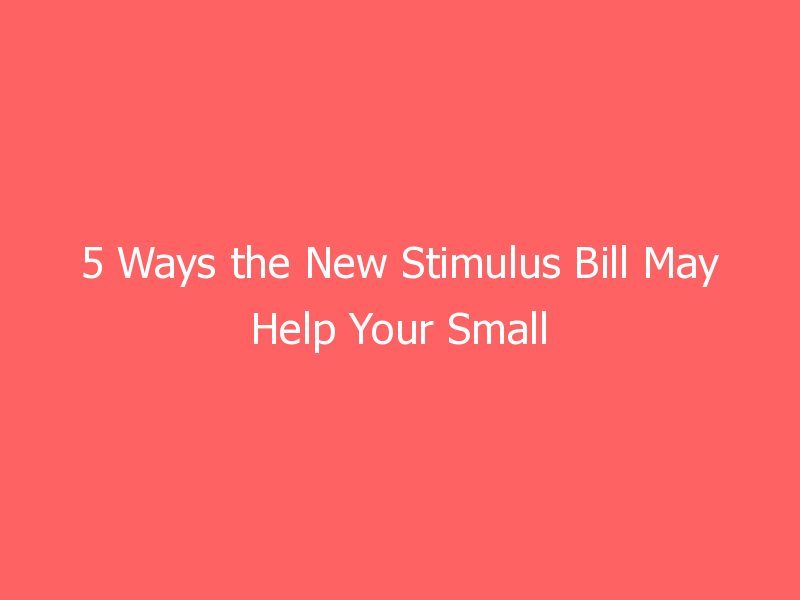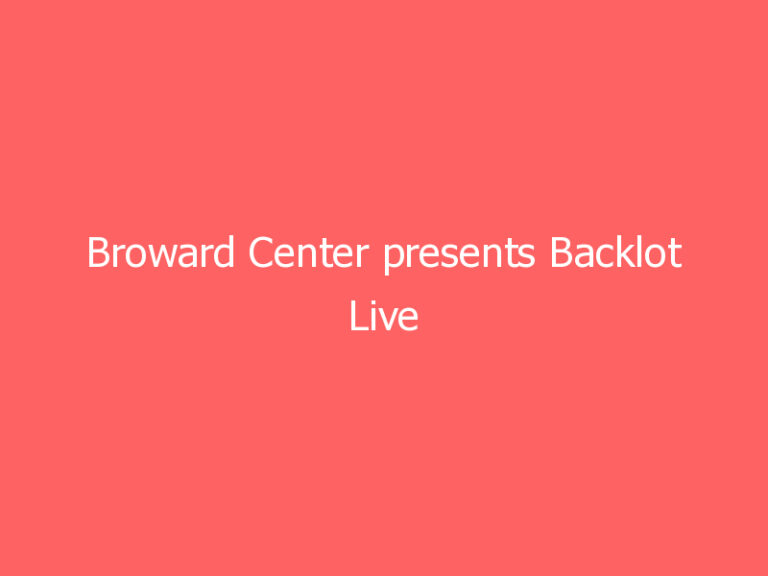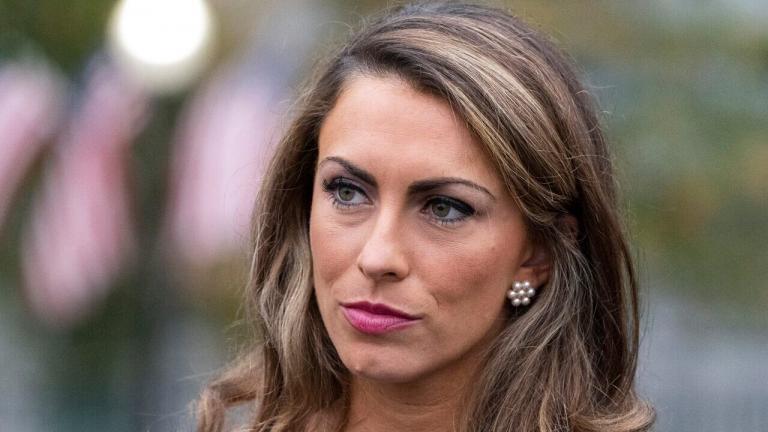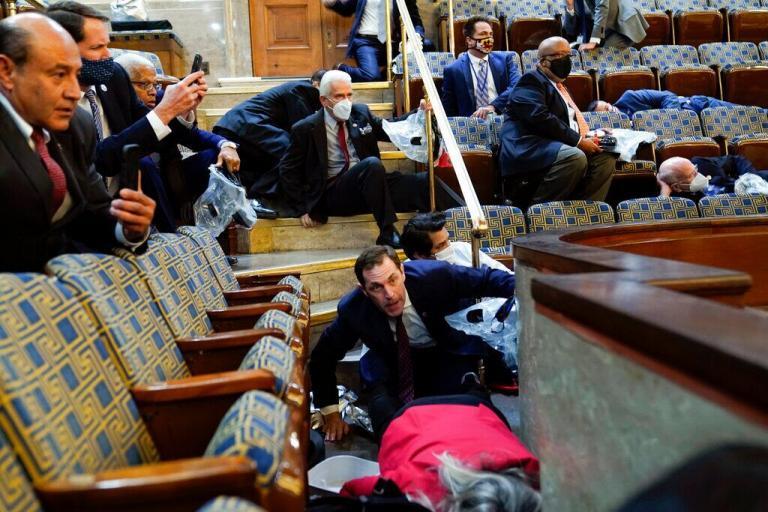Congress has just passed a second stimulus bill. If your small business has been struggling because of the Covid-19 pandemic, here are some important ways this new relief package may help.
The post 5 Ways the New Stimulus Bill May Help Your Small Business appeared first on AllBusiness.com. Click for more information about Gerri Detweiler. Copyright 2020 by AllBusiness.com. All rights reserved. The content and images contained in this RSS feed may only be used through an RSS reader and may not be reproduced on another website without the express written permission of the owner of AllBusiness.com.
The second stimulus bill, the Economic Aid to Hard-Hit Small Businesses, Nonprofits, and Venues Act, has been passed by Congress and signed into law by President Trump. While you may be hopeful that it will help your small business, you probably are also glazing over the fine print, unsure of whether you’ll actually be able to take advantage of any of the new relief.
To help, I’ve pulled out some of the key points from this bill that you should consider, as they may be relevant to you and your business—even if you’re a solopreneur or gig worker.
As happened after the CARES Act passed March 27, 2020, the Treasury Department and the Small Business Administration (SBA) will issue guidance that may change how this legislation is implemented. So use this as a starting point but don’t rely on it as the final word, or as guidance for your specific situation.
1. You may be eligible for a second PPP loan
As you recall from the CARES Act earlier this year, Paycheck Protection Program (PPP) loans were available to small businesses that had been negatively impacted by the coronavirus pandemic.
Those funds have been replenished, and even if you took out a loan the first time, you may qualify for another PPP loan. (New applicants who qualify are also welcome to apply under the original terms of the CARES Act.) The key is that if you did get a PPP loan already, you must have already used your funds or have plans to use them to qualify for further PPP funds.
Second draw PPP loans, however, put even more emphasis on very small businesses, including those that have:
- 300 or fewer employees and
- Had at least a 25% reduction in gross receipts in one or more quarters of 2020 when compared to comparable quarters the year before (with some caveats for seasonal and newer businesses)
What this means for you: Whether or not you took out a PPP loan the first time, if your business has continued to struggle in 2020, consider applying if you believe your business qualifies. These loans, just like the first round, may qualify for full forgiveness. And if you didn’t apply the first time because you didn’t think your business was big enough (maybe you’re a solopreneur with no employees), now may be the time to consider it.
2. You may pay less taxes
Prior to this bill, the expenses you paid for with funds from PPP were not eligible to be deducted on your taxes. The IRS determined that getting a forgivable loan that wasn’t taxed and then using that tax-free money to pay for expenses that you deducted on your taxes would be double dipping. Unfortunately, that meant some businesses were facing an ugly tax bill for 2020.
In addition, many businesses received a grant (advance) from the Economic Injury Disaster Loan (EIDL) program and the IRS was mum on whether those funds would be taxed. (Normally small business grants are taxable.)
Fortunately, this legislation fixes both of these problems.
Neither forgiven PPP loans nor EIDL grants will be taxed. And if you used your PPP or EIDL grant to pay business expenses that are normally deductible, you can take those deductions just like you would have last year before Covid-19 turned our world upside down.
What this means for you: Likely, less taxes to pay for 2020! Good news for all. As always, make sure you’re tracking your expenses in business accounting software so your accountant can easily refer to them when it’s time to file. That’s especially important here since PPP loans and EIDL grants or loans may be audited.
DON’T MISS: How to Get Your Second Stimulus Payment Direct Deposited to Your Bank Account
3. You may request more money from your first PPP loan
If you’re one of the many small businesses that returned their PPP loan, or that applied for less than they were entitled to receive in PPP funds the first time (maybe you didn’t realize you were considered an employee for payroll purposes, for example), you can now go back and request more funding.
What this means for you: Again, these funds are forgivable, so if you realize you might have qualified for more in loan funds the first time, having that cushion could be what your business needs to get through the coming months.
4. You may get the full $10,000 EIDL grant
There was quite a buzz earlier this year when the SBA first announced a $10,000 EIDL grant that didn’t need to be paid back, and then it died down when the SBA changed that to $1,000 per employee … and then funds ran out.
The EIDL grant is coming back, and qualifying businesses may indeed get the full $10,000 (minus any grant already received), even if they were turned down previously or were locked out because funds were exhausted.
However, there are stricter qualifications this time around. In addition to the qualifications in the original CARES Act, a business (including sole proprietors and independent contractors) must have 300 or fewer employees, be located in a low-income community, and have suffered an economic loss greater than 30% because of Covid-19.
What this means for you: The SBA will need to release specific guidelines and a new application process, but if you qualify, it means $10,000 you don’t have to pay back! This can go a long way to surviving the economic turbulence we’re in.
5. You may get a simplified forgiveness process for smaller PPP loans
This is another hotly contended subject on Capitol Hill: the PPP forgiveness process. Many business owners were hoping for automatic forgiveness for smaller loans, but that didn’t happen. Instead, thanks to this bill, there will be a new, simplified application for loans of $150,000 or less, including loans that have already been made but not forgiven.
What this means for you: If you fall into this category, you’ll be glad to know you don’t have the headache of a longer forgiveness application. The SBA has about a month to release this new form, and then you’ll apply for forgiveness through the lender that gave you your PPP loan. Don’t want to wait? You may be able to use the current simplified forgiveness application forms: 3508EZ or 3508S. Ask your lender for more information.
All in all, the measures passed in this bill mean help is on the way yet again for a number of small businesses. If you qualify, talk to your tax or financial advisors and consider taking advantage of the aid that’s being offered.
RELATED: New Relief Package Provides Next Round of PPP Funding for Small Businesses
The post 5 Ways the New Stimulus Bill May Help Your Small Business appeared first on AllBusiness.com. Click for more information about Gerri Detweiler. Copyright 2020 by AllBusiness.com. All rights reserved. The content and images contained in this RSS feed may only be used through an RSS reader and may not be reproduced on another website without the express written permission of the owner of AllBusiness.com.
Read More
Full content below:
The second stimulus bill, the Economic Aid to Hard-Hit Small Businesses, Nonprofits, and Venues Act, has been passed by Congress and signed into law by President Trump. While you may be hopeful that it will help your small business, you probably are also glazing over the fine print, unsure of whether you’ll actually be able to take advantage of any of the new relief.
To help, I’ve pulled out some of the key points from this bill that you should consider, as they may be relevant to you and your business—even if you’re a solopreneur or gig worker.
As happened after the CARES Act passed March 27, 2020, the Treasury Department and the Small Business Administration (SBA) will issue guidance that may change how this legislation is implemented. So use this as a starting point but don’t rely on it as the final word, or as guidance for your specific situation.
1. You may be eligible for a second PPP loan
As you recall from the CARES Act earlier this year, Paycheck Protection Program (PPP) loans were available to small businesses that had been negatively impacted by the coronavirus pandemic.
Those funds have been replenished, and even if you took out a loan the first time, you may qualify for another PPP loan. (New applicants who qualify are also welcome to apply under the original terms of the CARES Act.) The key is that if you did get a PPP loan already, you must have already used your funds or have plans to use them to qualify for further PPP funds.
Second draw PPP loans, however, put even more emphasis on very small businesses, including those that have:
- 300 or fewer employees and
- Had at least a 25% reduction in gross receipts in one or more quarters of 2020 when compared to comparable quarters the year before (with some caveats for seasonal and newer businesses)
What this means for you: Whether or not you took out a PPP loan the first time, if your business has continued to struggle in 2020, consider applying if you believe your business qualifies. These loans, just like the first round, may qualify for full forgiveness. And if you didn’t apply the first time because you didn’t think your business was big enough (maybe you’re a solopreneur with no employees), now may be the time to consider it.
2. You may pay less taxes
Prior to this bill, the expenses you paid for with funds from PPP were not eligible to be deducted on your taxes. The IRS determined that getting a forgivable loan that wasn’t taxed and then using that tax-free money to pay for expenses that you deducted on your taxes would be double dipping. Unfortunately, that meant some businesses were facing an ugly tax bill for 2020.
In addition, many businesses received a grant (advance) from the Economic Injury Disaster Loan (EIDL) program and the IRS was mum on whether those funds would be taxed. (Normally small business grants are taxable.)
Fortunately, this legislation fixes both of these problems.
Neither forgiven PPP loans nor EIDL grants will be taxed. And if you used your PPP or EIDL grant to pay business expenses that are normally deductible, you can take those deductions just like you would have last year before Covid-19 turned our world upside down.
What this means for you: Likely, less taxes to pay for 2020! Good news for all. As always, make sure you’re tracking your expenses in business accounting software so your accountant can easily refer to them when it’s time to file. That’s especially important here since PPP loans and EIDL grants or loans may be audited.
DON’T MISS: How to Get Your Second Stimulus Payment Direct Deposited to Your Bank Account
3. You may request more money from your first PPP loan
If you’re one of the many small businesses that returned their PPP loan, or that applied for less than they were entitled to receive in PPP funds the first time (maybe you didn’t realize you were considered an employee for payroll purposes, for example), you can now go back and request more funding.
What this means for you: Again, these funds are forgivable, so if you realize you might have qualified for more in loan funds the first time, having that cushion could be what your business needs to get through the coming months.
4. You may get the full $10,000 EIDL grant
There was quite a buzz earlier this year when the SBA first announced a $10,000 EIDL grant that didn’t need to be paid back, and then it died down when the SBA changed that to $1,000 per employee … and then funds ran out.
The EIDL grant is coming back, and qualifying businesses may indeed get the full $10,000 (minus any grant already received), even if they were turned down previously or were locked out because funds were exhausted.
However, there are stricter qualifications this time around. In addition to the qualifications in the original CARES Act, a business (including sole proprietors and independent contractors) must have 300 or fewer employees, be located in a low-income community, and have suffered an economic loss greater than 30% because of Covid-19.
What this means for you: The SBA will need to release specific guidelines and a new application process, but if you qualify, it means $10,000 you don’t have to pay back! This can go a long way to surviving the economic turbulence we’re in.
5. You may get a simplified forgiveness process for smaller PPP loans
This is another hotly contended subject on Capitol Hill: the PPP forgiveness process. Many business owners were hoping for automatic forgiveness for smaller loans, but that didn’t happen. Instead, thanks to this bill, there will be a new, simplified application for loans of $150,000 or less, including loans that have already been made but not forgiven.
What this means for you: If you fall into this category, you’ll be glad to know you don’t have the headache of a longer forgiveness application. The SBA has about a month to release this new form, and then you’ll apply for forgiveness through the lender that gave you your PPP loan. Don’t want to wait? You may be able to use the current simplified forgiveness application forms: 3508EZ or 3508S. Ask your lender for more information.
All in all, the measures passed in this bill mean help is on the way yet again for a number of small businesses. If you qualify, talk to your tax or financial advisors and consider taking advantage of the aid that’s being offered.
RELATED: New Relief Package Provides Next Round of PPP Funding for Small Businesses
The post 5 Ways the New Stimulus Bill May Help Your Small Business appeared first on AllBusiness.com. Click for more information about Gerri Detweiler. Copyright 2020 by AllBusiness.com. All rights reserved. The content and images contained in this RSS feed may only be used through an RSS reader and may not be reproduced on another website without the express written permission of the owner of AllBusiness.com.







